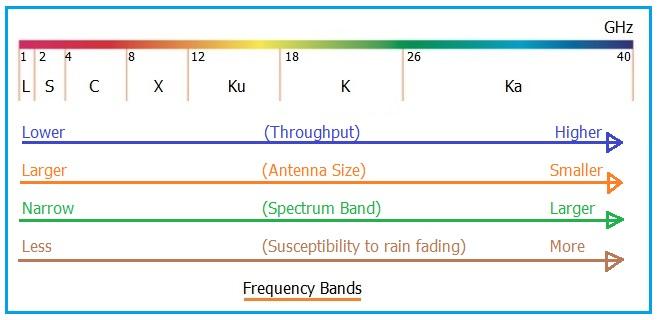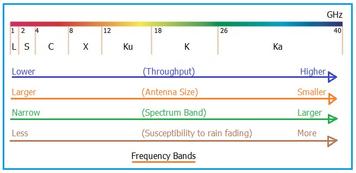L Band: Frequency Range, Wavelength, and Applications
The L band is a part of the electromagnetic spectrum that covers a specific range of frequencies from 1 GHz to 2 GHz.
Here’s a breakdown of its range, wavelength, applications, advantages, and disadvantages:
| Frequency Band | Frequency Range | Wavelength | Coverage Range (Km) |
|---|---|---|---|
| L Band | 1 to 2 GHz | 30 to 15 cm | Few hundred kilometers up to around 2000 Km (About 1240 miles) from the satellite. |
The L band frequency lies between the UHF Band and S Band, as illustrated below:

As noted in the table, the L band spans from 1 GHz to 2 GHz in the frequency spectrum.
The L band wavelength ranges from 15 centimeters (about 5.9 inches) to 30 centimeters (about 11.8 inches). The range for satellite communications and other applications can vary based on factors such as the specific frequency within the band, transmit power, antenna size, and atmospheric conditions.
For satellites, like Inmarsat, using L band frequencies, the typical coverage range extends from a few hundred kilometers to several thousand kilometers.
The lower portion of the L band (around 1.5 GHz) may have a longer range compared to the upper part (around 2 GHz).
L Band Advantages
Here are the advantages of the L Band compared to other frequency bands:
- Good Penetration: L-band signals exhibit good penetration capabilities, making them suitable for communication in Non-Line-of-Sight (NLOS) conditions.
- Less Susceptible to Interference: L band signals are less prone to atmospheric interference, increasing their reliability for communication and sensing in challenging environments.
- Compact Antennas: The shorter wavelength of L band allows for the use of relatively compact antennas, which is practical for mobile and portable communication devices.
- Global Coverage: Many L band systems, such as GPS and satellite phones, offer global coverage, ensuring connectivity in remote and inaccessible areas.
- Reduced Multipath Interference: L-band signals are less susceptible to multipath interference.
L Band Disadvantages
Here are the disadvantages of the L Band:
- Limited Bandwidth: L band frequencies have limited bandwidth, potentially restricting the data rates achievable in communication systems compared to higher frequency bands.
- Lower Resolution in Radar: In radar applications, L band frequencies provide lower resolutions compared to higher band frequencies, which might limit their suitability for certain surveillance and imaging tasks.
L Band Frequency Applications
L Band Frequency has a wide range of applications across various industries, including:
- Mobile and Satellite Communication: Their penetration capabilities make them suitable for various applications where signal penetration through clouds, foliage, and buildings is essential. This is especially valuable for mobile and satellite communication in non-line of sight (NLOS) conditions. They are also commonly used for global positioning systems (GPSs), satellite phones, and satellite based internet services.
- Aviation Communication: Used for aviation communication, including air traffic control (ATC) and aircraft-to-aircraft communication.
- Maritime Communication: Used for maritime communication systems, including navigation and distress signaling.
- Military Communication: L band frequencies are used by the military for secure and reliable communication.
- Radio Astronomy: Some radio astronomy observations are conducted in the L band to study celestial objects and phenomena.
- Remote Sensing: Used by radar systems for remote sensing applications, including soil moisture measurement, vegetation monitoring, and ocean surface monitoring.
- Weather Radar: Weather radar systems often operate in the L band to track precipitation and weather patterns.
 RF
RF


